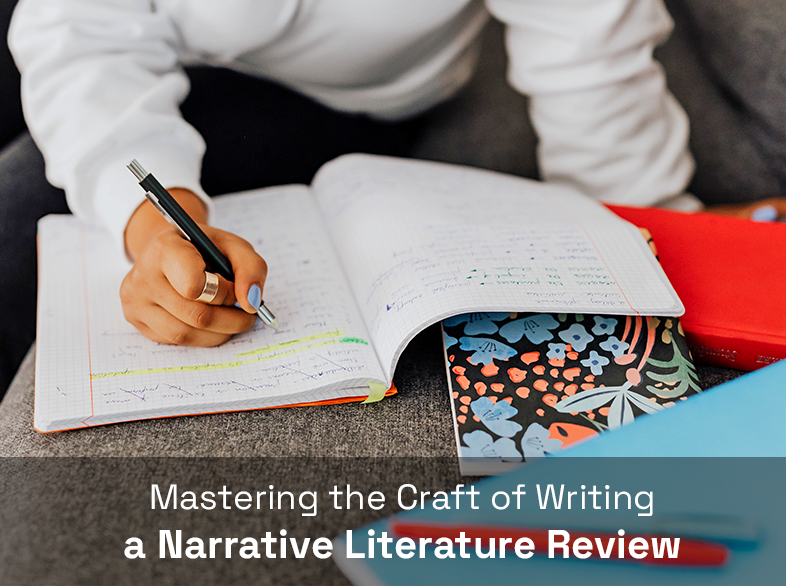
TOP 10 Writers

There are a lot of degree courses that set a requirement to write a narrative literature review for a high grade. So, after you have suggested an outline for your paper on the chosen topic, you also have to give a first-rate proposal. Still, a critical review of research conducted in the relevant topics is another challenge you have to face. Have you ever struggled with any papers? If you have, you know that it is not easy to meet all the expectations of your professors.
In brief, what you have to do to be effective in writing a narrative literature review is to make a comparison of corresponding literature. It has to be thorough and relevant to the research you have started. To be successful, it ought to imply in-depth analysis, proper evaluation, and precise identification of the gaps in the field. You do realize that this activity takes a lot of time and you have to know a lot to be effective. Let the writers of Best-writing-service.com get you a paper that you deserve. You can request for excellent writing and our experts will offer you customized help with any types of assignments. We cover all levels of writing, starting from high school, college, undergraduate, post-graduate, Master’s and PhD.
A modern student is always knowledgeable about the opportunities the Internet gives. Just a few clicks bring a lot of information. Googling opens up ample possibilities.
According to a definition, a narrative literature review is one of the research articles prepared for publication in peer-reviewed journals. Students in their first year frequently learn the basics of narrative review writing to gain an understanding of how to present their problem for study. Without any particular strategy of the search or question for the research, its focus is only on the topic of interest. Narrative reviews follow no standard protocols. They lack a systematic approach and they are never written to demonstrate full knowledge of the corresponding area of science.
Various databases contain indices of the published research articles; so, you can get studies for your research there. It is not enough to check on only one database. Limiting your search, you will neglect a lot of studies which could make your research brilliant. For instance, the most popular options of databases in the area of nursing are PsycINFO, PubMed, and CINAHL.
Publishing the research, authors identify the main keywords to help others make a quick and effective search for materials. Looking for the articles, analyze the keywords and insert corresponding ones in your own research. Try various keywords until you make sure that your review question is presented thoroughly.
Make sure that the search is completed. It is high time to review whether the abstracts of the articles you have chosen to know exactly that they are devoted to the problem of your interest. For sure, working on a narrative review of literature does not imply including all the relevant articles on the topic.
Make a summary of the findings you have and integrate all important things into your own writing. Using information from other studies, make references to the articles you have selected.


Have a look at a short list of the common mistakes that the most inexperienced writers make. By the way, they are frequent even in the manuscripts of writers with years of work on the problem.
Introduction of the topic is one of the key moments to pay special attention to. Skipping this stage, the writer develops the ideas inadequately and gets down to giving the concepts of the research when it is still not the right time to do that. If you have studied the narrative literature review definition thoroughly, you do know that it presents all findings relevant to the topic with the theory and integrative approaches. The only objective of the introduction is to sound convincing enough to make the readers believe that the topic for discussion is exciting and meaningful.
In most cases, it is essential to give a theoretical background of the problem as early as in the introduction. You need to help your readers as they want to know the key issues of your research at once instead of looking through dozens of pages to get to know about numerous findings before they actually understand what the paper is about. Also, it may not be enough for a publication to describe the findings in a simple manner without any reference to the theory.
One of the typical reasons for denial in publication is lack of citing from the literature taken for a narrative literature review. Inadequacy in coverage is usually explained with a little understanding of the readers’ expectations of and requirements for the task.
It is wrong to cover the available literature in an unbalanced manner. Too many pages are devoted to certain studies, while others are just mentioned superficially. If you want to be a successful journal reviewer, you need to know how to make a proper evaluation of the article and notice which information is missing.
The evidence in the area of behavioral and social sciences determines the quality of conclusions. If it is full of flaws, it has to be noted by a reviewer of narrative literature. It is a common mistake to disregard the flaws and concentrate on the strengths only. It is necessary to make a justified critical remark if there are some failures in the author’s work. Actually, it is a core responsibility in reviewing literature.
One of the explanations authors use to say that they neglect criticism is that their efforts are aimed at using a certain argument for building a new case. So, they claim that they have searched the literature to make their own viewpoint sound more convincing and have all the results collected. Nevertheless, one of the mistakes in the approach to articles is that the case is overstated. If the weaknesses are indicated in the review, it makes the value of manuscript reviews better; however, many of the authors believe that this may diminish it. The article may even grow in practical use if the empirical investigators get help and remarks about what should be done for improvements.
Working on a narrative literature review, you need to keep in mind that the weaknesses and flaws in the evidence can make the conclusions stronger. In some works, the authors critique the selected evidence, but the conclusions are strong and the critique is neglected. Going beyond the data, the narrative literature reviewers use another pattern. If an advisor or editor insists on changes after reviewing the first variant of the paper, it is necessary to add the critique. In that case, the author follows the advice and addresses the issues with the critique with no revision of the conclusions.
Empirical investigations are more subjective than narrative literature reviews, but the latter are more often biased and prejudiced. Learning how to write a narrative literature review, you see a theoretical principle or pattern for this writing in diverse areas of evidence and behavior. For sure, if you set a task to put together all the findings and get a ready paper according to the standards of effective writing, you need thorough search for relevant evidence to match the hypothesis and selected pattern.
If you ask us, ‘what is a narrative review for you?’ we would answer that it is one of the most privileged papers in the area of scientific enterprise. It has its own limitations, opportunities, and benefits. Only if individual researchers are aware of these differences, they will be more successful in writing.
Our skills are unequalled when it goes about working on a narrative writing review. We offer excellent professional support to our clients. We take into account all their requirements and desires and we highly appreciate if they delegate their tasks to us. You ought not to worry about deadlines as our effective team can cope with the most demanding cases, even if you believe that they are hopeless.
No time pressures can make us compromise on the quality of our writing. Whatever deadline you set, we handle the task with due care. Time is also one of the most precious resources and we will help you save both time and money with us.
Thus, as soon as you realize that you cannot do without professional support from the writers, you have to find a good solution. Actually, it is easy. Contact us and you will know the way out. Specify the assignment type and make a payment. We will assign a writer after that and your task will get into good hands. You can communicate about your narrative review with the assigned writer. We have a special messaging system and you may questions and comment on the text directly. We do value confidentiality and privacy of every client and we make sure that no one gets access to this correspondence. Every detail of our cooperation remains secret. Our customers are anonymous as we protect their rights without any exception.
Comparison table highlighting the key differences between a narrative literature review and a systematic literature review:
| Aspect | Narrative Literature Review | Systematic Literature Review |
|---|---|---|
| Purpose | Comprehensive overview, exploration of themes, and context | Specific research question/objective, evidence synthesis |
| Methodology | Less structured, flexible approach | Highly structured, predefined methodology |
| Research Question | Broad or general research question | Focused, specific research question |
| Search Process | Informal, non-systematic search | Systematic, comprehensive search |
| Study Selection | Selection criteria not always clearly defined | Strict inclusion/exclusion criteria |
| Data Extraction | Flexible, may vary among studies | Standardized data extraction |
| Bias Minimization | Limited measures to minimize bias | Stringent measures to minimize bias |
| Data Synthesis | Narrative summary, often qualitative | Quantitative analysis (meta-analysis) may be used |
| Transparency and Reproducibility | Less transparent, may lack reproducibility | High transparency, reproducibility is a priority |
| Research Output | Overview of existing knowledge, may suggest new research directions | Synthesized evidence-based conclusions, policy recommendations |
| Applicability to Decision Making | Provides context and diverse perspectives | Provides evidence for informed decision making |
| Time and Resource Intensity | Less time-consuming, requires fewer resources | Time-consuming, resource-intensive |
It’s important to note that the choice between a narrative and a systematic literature review depends on the research goals and the nature of the topic being investigated. Systematic reviews are typically favored when a rigorous and evidence-based approach is necessary, especially in fields like healthcare and policy-making, whereas narrative reviews are more suitable for exploring diverse viewpoints or providing broad overviews.
Here are two narrative literature review examples, one on the topic of “The Impact of Social Media on Mental Health” and the other on “Climate Change and its Effects on Biodiversity.” These examples are written in a narrative style:
Example 1: The Impact of Social Media on Mental Health
In recent years, the rise of social media platforms has transformed the way people communicate, share information, and connect with one another. While these platforms have undoubtedly brought about numerous benefits, such as facilitating global communication and information sharing, there is growing concern about their impact on mental health.
Several studies have explored the relationship between social media use and mental health outcomes. For instance, Smith et al. (2017) conducted a longitudinal study tracking the social media habits of 500 participants over two years. They found a significant correlation between excessive social media use and increased levels of anxiety and depression. Similarly, Jones and Brown (2019) examined the effects of social media on self-esteem and body image, revealing that exposure to idealized images on platforms like Instagram can lead to negative body image perceptions, particularly among adolescents.
Conversely, some researchers argue that social media can also have positive effects on mental health. A study by Williams et al. (2018) found that online support communities on platforms like Facebook can provide crucial emotional support to individuals facing mental health challenges. Additionally, the ability to connect with friends and family, even when physically distant, has been shown to have a positive impact on overall well-being.
In conclusion, the relationship between social media and mental health is complex and multifaceted. While there is evidence to suggest that excessive social media use and exposure to certain content can have detrimental effects on mental health, there are also instances where social media platforms can serve as valuable sources of support and connection. Further research is needed to better understand the nuances of this relationship and develop strategies to mitigate potential harms.

Submit your personal
information and literature
review requirements.

Proceed with payment.

Get an order confirmation.

You can communicate
with your writer.

We will upload your
literature review into
a personal account.
Example 2: Climate Change and its Effects on Biodiversity
The ongoing issue of climate change represents one of the most significant environmental challenges of our time. As global temperatures continue to rise due to human activities, the impact on biodiversity has become a subject of intense research and concern.
Numerous studies have documented the ways in which climate change is altering ecosystems and affecting species diversity. For example, Parmesan and Yohe (2003) conducted a meta-analysis of over 1,700 species and found that many have undergone shifts in their geographic ranges in response to changing climate conditions. Species that cannot adapt or migrate face the threat of extinction.
Furthermore, climate change has disrupted the timing of seasonal events, such as flowering, migration, and hibernation, leading to mismatches between species’ life cycles and the availability of essential resources. This can result in reduced reproductive success and population declines (Thackeray et al., 2010).
On the positive side, some researchers have observed that certain species exhibit adaptive responses to climate change, such as changes in behavior, physiology, or genetic traits. These adaptations suggest that biodiversity may possess some degree of resilience in the face of ongoing environmental shifts (Bellard et al., 2012).
In summary, climate change poses a significant threat to biodiversity, with potentially dire consequences for ecosystems and the services they provide to humanity. While some species demonstrate adaptive capacity, the overall trend is one of disruption and loss. Urgent global action to mitigate climate change and protect vulnerable species is essential to preserving biodiversity for future generations.



